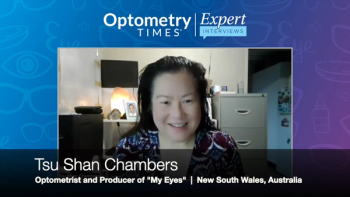
Quick vision performance test: A potential new way to analyze functional vision
The qVPT, a suprathreshold test comprised of 15 trials at 9 cycles per degree and 20% contrast, measures the patient’s response time to visual stimuli and the number of correct responses.
A proposed new vision test, the Quick Vision Performance Test (qVPT), may serve as a new way to rapidly assess functional vision, according to Dmitry Romashchenko, PhD, the first author of the study. He is from Johnson & Johnson MedTech, Vision, Research and Development, Groningen, the Netherlands. He and his colleagues described the qVPT at the Association for Research in Vision and Ophthalmology 2025 annual meeting in Salt Lake City, Utah.
Description of the test
The qVPT, a supra-threshold test comprised of 15 trials at 9 cycles per degree and 20% contrast, measures the patient’s response time to visual stimuli and the number of correct responses. In their assessment of the use of the test in this study, the investigators explained, the time of the stimulus presentation was not limited and the participants were asked to perform the test as quickly and accurately as possible.
To obtain the best focus, the higher-order aberrations were corrected, and the average primary spherical aberration was induced and compensated for by the IOL.
The study was designed to assess functional vision of the participants through intraocular lenses (IOLs). The results of qVPT testing then were compared with those obtaining using the quick contrast sensitivity function (qCSF) test.1
From the measurements performed, the investigators calculated the percentage of correct responses (ie, the hit rate) and the response time and hit-rate deviation compared to a monofocal IOL at the best focus (ie, the defocus range).
In this experiment, testing was done for an aspheric monofocal and multifocal IOL with an add power of +3.25 diopters (D). The base power of each IOL was 20 D.
In the qVPT portion of the experiment, 3 subjects were tested; in the qCSF portion 3 subjects were tested for the monofocal IOL and 2 for the multifocal IOL. The measurements ranged from -1.0 to +1.0 D of defocus in 0.25-D steps, Romashchenko described.
Study results
“The qVPT took an average of 17 ± 5 seconds to complete compared to 2 to 3 minutes for the typical qCSF measurement,” the investigators reported.
They related that with the qVPT, both the monofocal and multifocal IOLs had a high hit rate of 99%. They also reported that with the qVPT, the response time for the multifocal IOL was 17% longer compared with the monofocal IOL. The area under the qCSF of the multifocal IOL was 14% lower compared with the monofocal IOL.
Regarding the defocus range, for the qVPT hit rate, the defocus range was comparable between the IOLs.
Regarding the response time for the qVPT, the defocus range was larger for the monofocal IOL compared to the multifocal IOL. The defocus range for the area under the qCSF, the response time was similar to that of the qVPT, with the monofocal IOL having a larger defocus range, they reported.
Based on the results, the investigators believe that the proposed qVPT test provides a quick method for assessing the functional vision, which can complement conventional threshold vision tests. “The calculated defocus ranges are comparable between the qVPT and the qCSF and suggest that the monofocal IOL is more resilient to a small amount of defocus compared with the multifocal IOL.”
They pointed out that the current results agree with previous results that showed that multifocal IOLs are sensitive to small amounts of residual refractive errors.2
References
1. Lesmes LA, Lu Z-L, Baek J, Albright TD. Bayesian adaptive estimation of the contrast sensitivity function: The quick CSF method. J Vis. 2010;10:17. doi:
2. Woodward MA, Randleman JB, Stulting RD. Dissatisfaction after multifocal intraocular lens implantation. J Cataract Refract Surg. 2009;35:992-997. doi: 10.1016/j.jcrs.2009.01.031
Newsletter
Want more insights like this? Subscribe to Optometry Times and get clinical pearls and practice tips delivered straight to your inbox.



















































.png)


